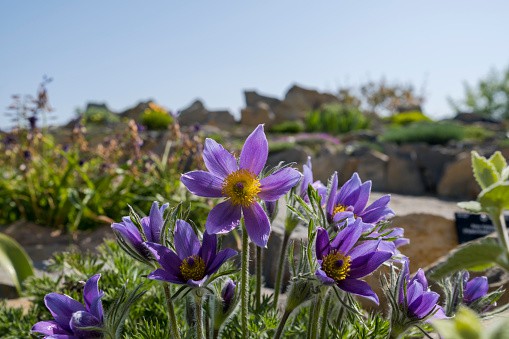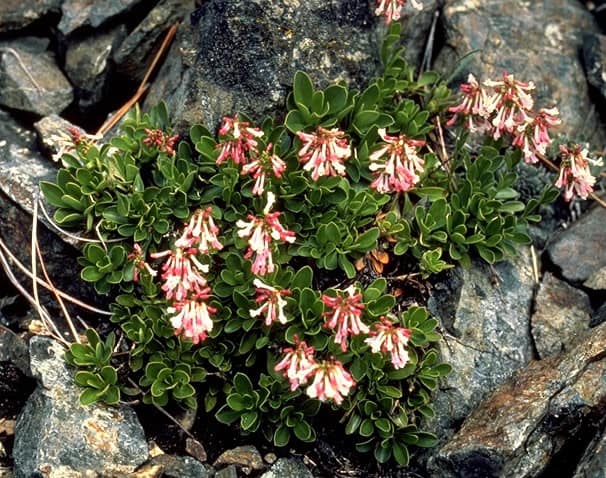Pasque flowers, also known as Pulsatilla vulgaris, are a type of early-blooming perennial. The flower has a large and showy appearance, with each plant able to produce up to 30 bell-shaped blossoms. The shape of the flowers varies from blue to purple, with a bright yellow center full of fluffy stamens. Pasque flowers have a silky and fern-like foliage, and make for a perfect addition to the front of a border or rock garden.
Classification
Pasque flowers, or Pulsatilla vulgaris, belong to the Pulsatilla family, which is a group of flowering plants. They are a type of perennial, meaning they will bloom year after year, as long as they are taken care of properly.
Meaning and Symbolism
In traditional folklore, Pasque flowers were seen to be a representation of a passion that is taken too far, as the flower blooms right after a harsh winter. This symbolism was seen to signify a passionate but short-lived winter romance.
History and Mythology
Pasque flowers have a deep and fascinating history. In early Christian tradition, Pulsatilla vulgaris was seen to represent Jesus as he was resurrected from his tomb after death. This symbolism was also seen in Norse mythology, which characterized it as a flower of hope, a symbol of perseverence in the face of death.
Flower Varieties
Within the Pasque Flower, there are three primary varieties:
- Purple Pasque- This variety of Pulsatilla vulgaris has a purple hue and is thought to represent a passionate and short-lived winter romance.
- Blue Pasque- This variety of Pasque Flower has a blue hue, which symbolizes depth and sincerity.
- White Pasque- This variety of Pasque Flower has a white hue, which is said to represent purity and peace.
How to Plant
Pasque flower can be planted outdoors or indoors, depending on your preference. The flower prefers light environments, so it is best to place it in a spot with indirect sunlight. Regarding soil, the flower needs a moist but well-draining soil to do its best. If planting the flower outdoors, it is a good idea to cover the soil with mulch to hold moisture and prevent weeds.
When it comes to watering, Pasque flower prefers slightly moist soil. However, it is important to keep an eye on your flower, as over-watering can cause root rot.
To care for your Pasque flower, you should also add a balanced fertilizer once a month, as this will help promote further growth and blooms. Temperatures should remain consistent for Pasque flower and generally be between 55 to 75 degrees Fahrenheit.
How to Pot and Repot
If planting the flower indoors, you should use a potting mix specifically designed for Pasque flowers. The mix should include perlite, vermiculite, and peat and should be well-draining to prevent root rot.
When it comes to potting and repotting your Pasque flower, you should use a pot that is slightly bigger than the current one, as this will help the flower develop the necessary roots. When transferring your Pasque flower to the new pot, be sure to gently loosen the roots, as they may have attempted to attach themselves to the old pot. After the flower has been placed, you should add the necessary soil until it is at the top of the pot.
How to Prune
Pruning Pasque flowers is a great way to encourage further growth and blooming. When it comes to pruning, you should wait until the plants have finished flowering for the season and are beginning to die down before you begin. It is at this point that you should begin to prune any dead or diseased foliage and branches. This will enable new and healthy stems and branches to grow and eventually produce further blooms.
How to Propagate
You can propagate Pasque flower using the cuttings from the flowers, stems, or even leaves. To do this, select a healthy piece of the flower and place it into a jar of water. Once the cutting has rooted, you can transfer it to soil and in no time you will have new Pasque flowers to enjoy.
Common Pests and Diseases
The Pasque flower is known to be relatively pest- and disease-resistant, but it is important to keep an eye out for any damage caused by pests or diseases. The most common pest you will need to watch out for is the spider mite, which can cause serious damage if it is left untreated.
To protect your Pasque flower from disease, try to remove any dead foliage or stems to reduce the risk of it striking your plant.
Frequently Asked Questions
Q. How often should I water my Pasque flower?
A. Pasque flower prefers moisture, but it is important to keep an eye on the soil and ensure that it is not becoming waterlogged. Aim to water your Pasque flower once or twice a week, but monitor the soil to ensure it is not becoming overly saturated.
Q. How long do Pasque flowers last?
A. Pasque flowers are a type of perennial, which means they will bloom year after year, as long as they are taken care of properly. In optimal conditions, each Pasque flower can last up to five years.
Q. What Hues Do Pasque Flowers Come In?
A. Pasque flowers are typically seen in shades of purple, blue, and white.
Fact Sheet
| Family | Pulsatilla |
| Plant Type | Perennial |
| Mature Size | 2-3 inches |
| Sun Exposure | Indirect |
| Soil Type | Moist and Well-Draining |
| Soil pH | 6.5-7.5 |
| Bloom Time | Spring |
| Flower Color | Purple, Blue, White |
| Hardiness Zones | 3-7 |
| Native Area | North Africa, Europe, Central and South Asia |
What we love from Amazon this week
Buy these wonderful flowers directly from Amazon:














